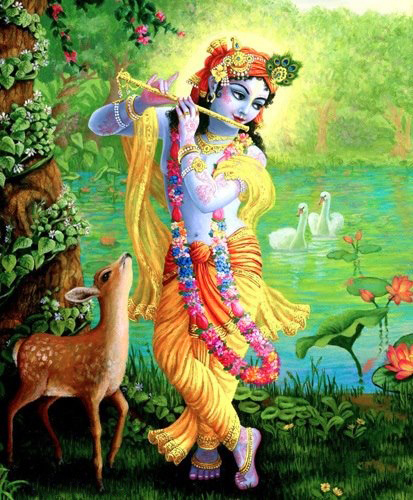
Krishna West teaches the spiritual science of bhakti-yoga – devotional wisdom and practice – from timeless Sanskrit texts, including Bhagavad-gītā and Śrīmad-bhāgavatam. This tradition has gifted the world yoga, meditation, animal rights, and the vision of all living beings as divine parts of God.
Do you know who you are, or do you merely think you know? And does it really matter? Bhagavad-gītā, widely revered as a work of spiritual and philosophic genius, excels in providing reasonable, satisfying responses to life’s biggest issues: Who am I? Why do I exist? What is the universe? What is God?
We are not the body, we are eternal individual persons.
There are two main energies: spiritual and material. The superior spiritual energy is the source of consciousness and is eternal, full of knowledge and bliss. The inferior material energy, like bodies and other material objects, has no consciousness and is in constant flux.
“Every living being in this world is an eternal spiritual soul encased in a temporary material body. Each soul has always existed and will always exist as a personal individual being. Only the material body begins and ends, for the soul is never born and never dies. The soul is God’s superior living energy, a part of God, Krsna. And God is kindly disposed toward every soul.”


There is a Supreme Being, known by many names across many traditions.
God is unlimited and has unlimited names. Krishna is a name of God which means all attractive. Krishna is the source of beauty, power, strength, intelligence, fame, and renunciation – opulences that we are all seeking.
The Bhagavad-Gita stresses several features of God (Krishna):
- God is one.
- God is the source of all.
- God is fair and not jealous.
- God loves us.
- Creator and creation are one and different.
- Krishna, the Divine Person, exists with form: a body that is inconceivable, sun-colored and smaller than an atom, yet infinite, majestic, astonishing, made of splendor, original, revealed by Krishna’s own mystic power and resembling that of a human being.
Additionally, Krishna pervades all of existence and is present within the heart of every living being.
Everyone has a relationship with Krishna.
- Individual souls, such as ourselves, are parts and parcels of Krishna, who is the Supreme Soul, or Super-Soul. God and soul are simultaneously one and different. Just as a drop of water from the ocean has the same properties as the entire ocean but the quantity is vastly different, souls are one with God in quality while different in quantity.
- The basic fact of the living condition is that we have a natural tendency to love someone. We all want loving relationships with our partners, families, friends, pets… If we can repose this loving propensity in Krishna, we can achieve permanent happiness. This relationship with Krishna already exists and is just waiting to be awakened.
Nature’s Three Modes — Gunas
As human color vision is trichromatic, based on three primary colors, so worldly life exists within a tri-modal system of goodness passion, and darkness. Just as we seldom find natural objects in pure primary colors, so the things of this world seldom embody pure primary modes. People and objects tend to show complex mixtures of the modes. Thus a person has a good side, but also a passionate side, and even a dark side. The material modes permeate every object, emotion, act, and ambiance in this world, including food, faith, work, worship, charity, philosophy, bodies, and buildings. Indeed every free choice we make is a moral choice: good, passionate, or dark—with infinite combinations.
For example, when we give charity for a good cause, solely to help others, and with no desire for return, we give charity in goodness. When we help others, but also seek fame or profit through our gifts, we give in passion. And giving that does more harm than good is in darkness, such as a gift that enables one with clear criminal intent to harm the innocent. Thus the quality or mode of our giving affects the quality of our life.
These three modes bind us to this world, and in that bound state, we cannot fix our minds on our eternal existence. Again and again, we compulsively try to enjoy the world, regardless of what our pure reason, in the form of muffled, gagged conscience, tries to tell us about true self-interest. To transcend this illusory state, we must adjust our association. By associating with spiritual energy, spiritual people, etc., we revive our spiritual nature. We then easily, spontaneously, naturally act for our highest self-interest.
The Bhagavad-gita, verse 2.45, recommends cultivating a life of goodness in connection to Krishna, thereby reaching a state of transcendence (pure goodness), which is beyond the three modes and temporary happiness and suffering.
Action and Reaction — Karma
Karma refers to the cosmic system that reacts to our free acts, delivering to us fair, commensurate consequences. In this way, the universe holds up a mirror to each soul.
When we identify with the body, we cling to the fruit of the body’s actions. We do this because we are locked into the duality of attachment and aversion and thus seek to enjoy what we like and avoid what we dislike. Since we thus lay claim to ownership of our actions, we are held responsible for the reactions to those actions as well. Simple! So we return to this world life after life to receive, enjoy and suffer the results of our actions– and that is karma.
The very universe that binds us to karma offers us a path to freedom: yajña, sacrifice, or offering. Apart from this loophole, or escape clause, the whole world is but an endless variety of karma-bondage. Yajña transforms matter into spirit and dissolves karma.
